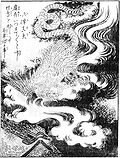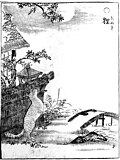Toriyama Sekien (鳥山 石燕, 1712 – September 22, 1788), real name Sano Toyofusa, was a scholar, kyōka poet, and ukiyo-e artist of Japanese folklore. Born...
5 KB (512 words) - 04:59, 12 May 2024
Gazu Hyakki Yagyō (redirect from Hyakki Yakō (Toriyama Sekien))
Demon Horde's Night Parade) is the first book of Japanese artist Toriyama Sekien's famous Gazu Hyakki Yagyō e-hon tetralogy, published in 1776. A version...
9 KB (815 words) - 18:25, 21 December 2023
ophthalmologist and photographer Motomu Toriyama, Japanese game director and scenario writer Toriyama Sekien (1712–1788), scholar and ukiyo-e artist This...
536 bytes (100 words) - 08:43, 8 March 2024
[This quote needs a citation] In the Edo period, many artists, such as Toriyama Sekien, invented new yōkai by taking inspiration from folk tales or purely...
37 KB (4,077 words) - 06:43, 10 July 2024
Ehon Hyaku Monogatari (section Toriyama Sekien)
Shunsensai, published about 1841. The book was intended as a followup to Toriyama Sekien's Gazu Hyakki Yagyō series. Like those books, it is a supernatural bestiary...
13 KB (1,389 words) - 16:51, 21 December 2023
the Gazu Hyakki Yagyō by Toriyama Sekien. The illustration does not give any explanatory text, but according to Toriyama Sekien Gazu Hyakki Yagyō, (editor-in-chief...
3 KB (399 words) - 10:04, 5 July 2023
(網(あみ)切(きり) or 網剪) is a Japanese yōkai depicted in the Gazu Hyakki Yagyō by Toriyama Sekien. It is depicted as a cross between a serpent, bird or a lobster. It...
4 KB (515 words) - 00:51, 13 May 2024
the Present and the Past") is the second book of Japanese artist Toriyama Sekien's famous Gazu Hyakki Yagyō tetralogy, published c. 1779. A version of...
7 KB (436 words) - 18:07, 21 December 2023
(垢(あか)嘗(なめ), 'scum-licker'; 'filth-licker') is a Japanese yōkai depicted in Toriyama Sekien's 1776 book Gazu Hyakki Yagyō, with its precursor or equivalent akaneburi...
18 KB (1,660 words) - 19:02, 18 May 2024
similar to noppera-bō but as an adjective. The Gazu Hyakki Yagyō by Toriyama Sekien depicts a nurarihyon hanging down from a kago. Like the emakimono,...
14 KB (1,949 words) - 09:05, 3 May 2024
woman") was a Japanese yōkai that appeared in the Gazu Hyakki Yagyō by Toriyama Sekien. The Gazu (illustrated reference) above depicts a woman with an elongated...
6 KB (779 words) - 21:01, 18 December 2022
Sawaki Suushi. They are also depicted in the Gazu Hyakki Yagyō by Toriyama Sekien. They are depicted as an animated corpse with darkened skin and dangling...
9 KB (1,180 words) - 18:06, 23 June 2024
Japanese collection of Yōkai pictures, the Konjaku Gazu Zoku Hyakki by Toriyama Sekien published in 1779. Its picture has the explanatory text, "as explained...
4 KB (544 words) - 08:29, 20 March 2024
The ouni (苧うに) is a yōkai depicted in the Gazu Hyakki Yagyō by Toriyama Sekien. It is a yōkai with a face like that of a demon woman (kijo) torn from...
5 KB (579 words) - 09:57, 5 July 2023
period as otogizōshi (prose narratives), and were also mentioned by Toriyama Sekien in Konjaku Hyakki Shūi. Edo period folklore then conflated the legend...
7 KB (768 words) - 21:29, 22 April 2024
kiinushii. In the collection of yōkai depictions, the Gazu Hyakki Yagyō by Toriyama Sekien, under the title 木魅 ("kodama"), an aged man and woman are depicted...
6 KB (814 words) - 22:38, 7 January 2024
Hyakkai Zukan by Sawaki Suushi and the Gazu Hyakki Yagyō (1776) by Sekien Toriyama. In the Hyakkai Zukan (1737, Sawaki Suushi), Bakemonozukushi (化物づくし)...
7 KB (970 words) - 03:35, 3 June 2024
that is related to the meaning, but not the sound of the word. In Toriyama Sekien's Gazu Hyakki Yagyō, it is depicted as a spider woman manipulating small...
12 KB (1,717 words) - 18:29, 5 June 2024
works in this motif include those by Toriyama Sekien (Gazu Hyakki Yagyō) and Utagawa Yoshiiku. However, Toriyama's work presents yōkai in separate, encyclopedic...
6 KB (680 words) - 22:46, 27 April 2024
ISBN 978-4-06-277602-8. Toriyama, Sekien; 鳥山石燕 (2017-01-18). Japandemonium illustrated : the yokai encyclopedias of Toriyama Sekien. Yoda, Hiroko,, Alt,...
21 KB (2,936 words) - 06:08, 23 August 2023
Zoku Hyakki (1779) by Toriyama Sekien. As its name implies, it depicts this yōkai as a woman in the form of bones. In Sekien's explanatory text in the...
3 KB (341 words) - 14:14, 8 March 2023
draws from it. In the Morinji no Kama from Konjaku Hyakki Shūi by Toriyama Sekien, it was named "Bunbuku" from the expression "Bunbukuka" (文武火), meaning...
19 KB (2,244 words) - 15:11, 16 June 2024
from the Present and the Past") is the third book of Japanese artist Toriyama Sekien's Gazu Hyakki Yagyō tetralogy, published c. 1781. These books are supernatural...
17 KB (1,910 words) - 18:06, 21 December 2023
illustrated in Toriyama Sekien's mid-Edo period Konjaku Gazu Zoku Hyakki, as an infant spirit lapping oil out of an andon lamp. Sekien's accompanying notes...
7 KB (927 words) - 18:05, 23 June 2024
anything other than a black cloud, but in the Gazu Hyakki Yagyō by Toriyama Sekien, they are depicted on top of a sluice. However, there is no accompanying...
9 KB (1,235 words) - 16:31, 13 November 2023
allowing people to coexist with satori. A satori is depicted in Toriyama Sekien's Konjaku Gazu Zoku Hyakki, but since this was modeled after the yamako...
5 KB (632 words) - 04:35, 11 April 2024
almost two decades) is an enenra.[better source needed] Toriyama, Sekien (2005). Toriyama Sekien Gazu Hyakki Yagyō Zen Gashū. Kadokawa Sophia Bunko (in...
2 KB (197 words) - 19:16, 19 May 2024
The noderabō is a Japanese yōkai from Toriyama Sekien's Gazu Hyakki Yagyō and is thought to be a yōkai that appears at abandoned temples. The Gazu Hyakki...
4 KB (649 words) - 22:27, 20 June 2024
kamae tachi ("stance sword"), but like the kyūki in the "Yin" part of Toriyama Sekien's Gazu Hyakki Yagyō, they were thus[how?] re-used and depicted as a...
15 KB (2,060 words) - 02:32, 21 December 2023
patch up the holes in it. Mokumokuren are said to be an invention of Toriyama Sekien. A stingy traveling merchant once tried to save money by sleeping in...
2 KB (234 words) - 14:21, 8 March 2023

























